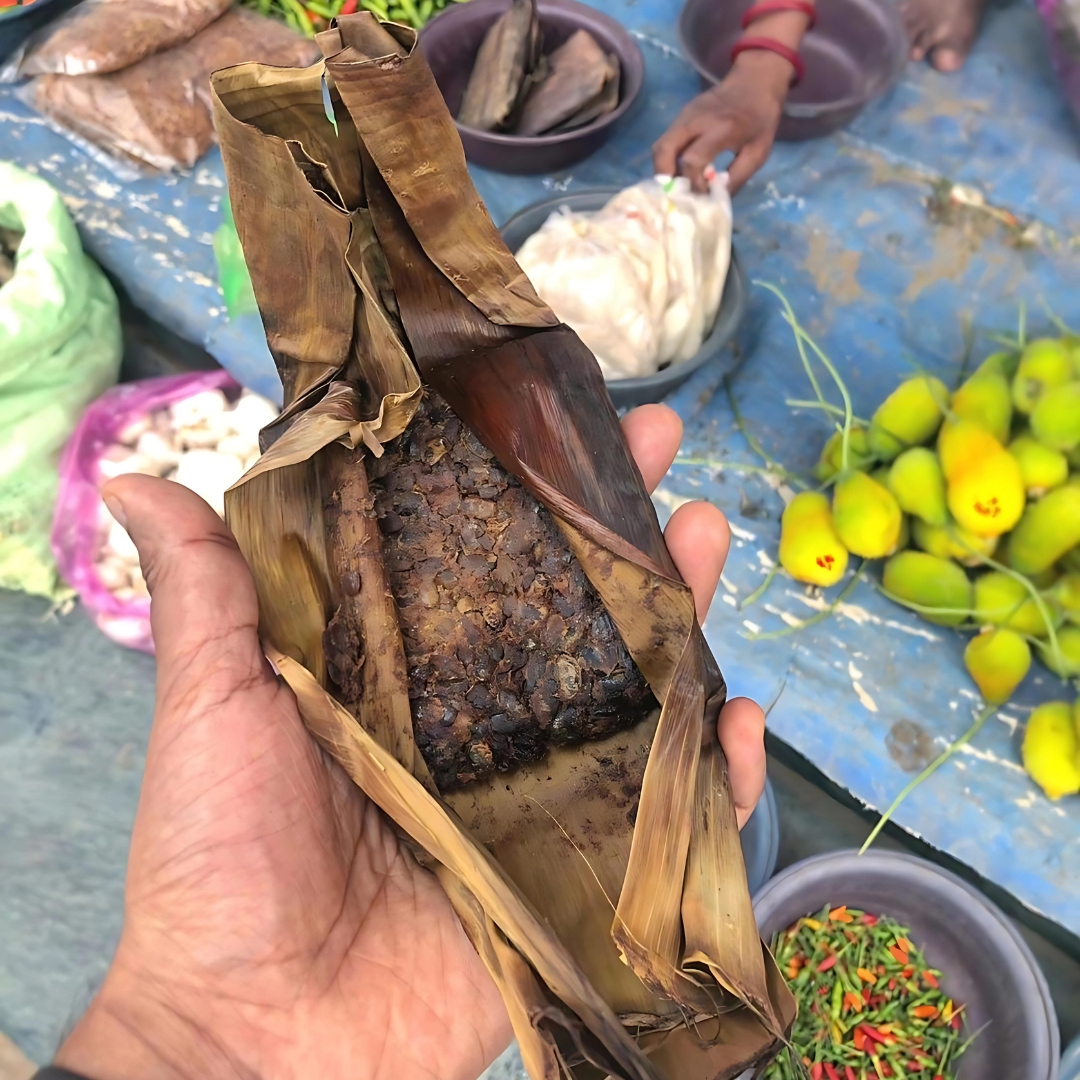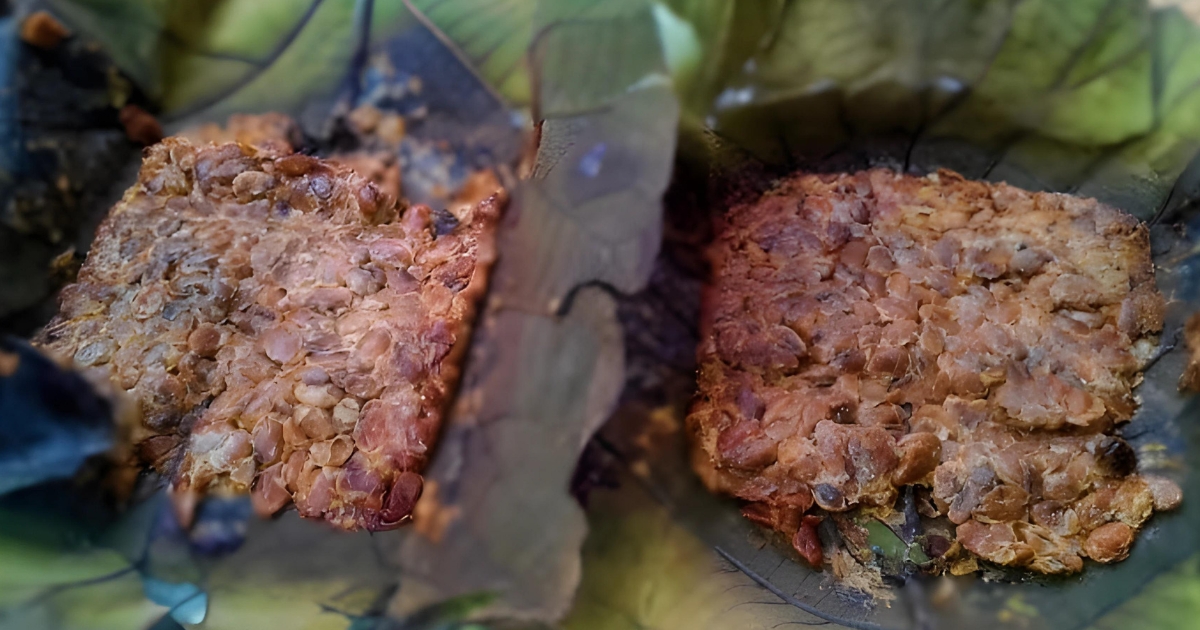Many people find the idea of making traditional Naga dishes at home daunting. Axone, a fermented soybean paste crucial in Naga cuisine, is known for its intense flavour and health benefits.
This article will guide you through making Axone easily, showing every step from soaking to fermentation. Let’s explore this unique culinary tradition together.
Traditional Preparation of Axone
The making of Axone starts with the fermentation of soya beans, a process deeply rooted in the traditions of Sumi Naga people from Zunheboto. Craftsmen expertly wrap these fermented beans in banana leaves and place them in bamboo baskets to enhance their unique umami flavour.
Fermentation of Soybeans
Fermentation starts with washing and soaking the soybeans overnight. This softens them, making it easier to cook until they’re perfectly tender. After cooking, we mash these beans into a thick paste using traditional tools or even our hands for that personal touch.
Next, this paste gets wrapped in banana leaves, which are crucial for imparting a unique flavour while keeping the paste moist during fermentation. We place the wrapped bundles in bamboo baskets – a method passed down through generations in Nagaland – creating an ideal environment for fermentation to occur naturally over the next few days.
This process relies heavily on indigenous techniques that have cultured flavours distinctive to Northeastern Indian cuisine, particularly among Sumi Naga communities in Zunheboto district.
Throughout this journey of transformation, the once plain soybean evolves into Axone, bursting with umami flavour thanks to its time-honoured fermentation rites.
Use of Bamboo Basket and Banana Leaves
The Sumi tribe uses bamboo baskets lined with banana leaves to ferment soybeans. This method creates Axone, a protein-rich legume with a unique umami flavor. The natural materials allow for indigenous fermentation, vital for achieving the traditional taste and texture of this cherished dish.
These environmentally friendly tools play a critical role in preserving the cultural significance of Axone within Indian and Naga cuisines.
Bamboo baskets and banana leaves are not just containers but keepers of tradition, aiding in transforming simple soybeans into the flavorful Axone.
This process showcases an eco-friendly approach to food preparation, connecting people to their heritage while promoting sustainable practices. As these soybeans slowly ferment within the basket’s embrace under banana leaf coverings, they develop characteristics essential for various recipes like curries, chutneys, and pickles.
The practice is more than culinary; it’s a bridge between generations, teaching patience and respect for time-honored techniques.
Also Read: Danhop: A Fashion Fairytale Born in the Heart of Dimapur
Role of Microbes in Axone Preparation
In the making of Axone, tiny organisms like Bacillus Subtilis play a key role. These micro-organisms start the fermentation process, turning soybeans into a flavorful ingredient for dishes.
Contribution of Bacillus Subtilis
Bacillus Subtilis plays a vital role in making Axone, a fermented soybean product loved by Indians and Nagas. This microbe starts the fermentation process that transforms soybeans into a flavorful and aromatic paste.
Its work doesn’t stop there. Bacillus Subtilis also adds to Axone’s nutritional value, packing it with probiotics beneficial for gut health.
This bacteria’s magic makes the traditional method of wrapping soybeans in banana leaves and leaving them to ferment an essential culinary practice. Without Bacillus Subtilis, the unique taste and fragrance that define Axone wouldn’t exist.
Its presence turns simple ingredients into a delicacy by fostering microbial diversity crucial for food preservation in indigenous cultures.
Also Read: Fastfoodie: Connecting Customers, Restaurants, and Youth in Nagaland
Health Benefits of Axone
Eating Axone, made from fermented soybeans, boosts your protein digestion, making it easier for your body to absorb this vital nutrient. Discover the power of traditional foods in improving your health today.

High Digest Protein
Axone, a treasured fermented soyabean paste from Nagaland, stands out for its high digest protein. This remarkable food item undergoes a unique fermentation process that not only enhances its flavour but also boosts the protein’s ease of digestion.
The Sumi Naga tribe has mastered this culinary art, producing Axone with proteins that your body can easily absorb and use. Fermenting soyabeans transforms them into a powerhouse of nutrients, making Axone an essential component in the diets of many in India and among the Naga communities.
Protein is essential for building muscles and repairing tissues; Axone delivers this in a highly digestible form.
I have personally added Axone to my meals and noticed an improvement in my overall health. Its versatility means it can turn a simple bowl of sticky rice or add depth to a curry, providing both nutritional benefits and rich flavours.
As someone who values both nutrition and cultural authenticity in food, discovering Axone has been incredibly rewarding.
Also Read: James Pochury Advocates for Nagas at UN Forum
Peculiarities of Axone

Axone stands out for its unique aroma and flavor, which comes from the traditional process of fermenting soybeans. This special taste captures the essence of Naga culture, making it a cherished ingredient in many dishes.
Distinct Smell and Taste
The process of making Axone at home brings out its strong pungent smell, setting it apart from other fermented foods. This unique aroma comes from the traditional methods used during soybean fermentation. People often recognise it just by its smell before they even taste it.
Tasting Axone reveals another layer of its uniqueness. Unlike typical soy products, Axone has a flavour that is both rich and complex, appealing to those who appreciate depth in their food.
Its taste is a direct result of the essential microbes involved, especially Bacillus subtilis found during the fermentation process. These elements combine to give Axone a memorable taste profile that stands out in Naga cuisine as well as among Indian fermented delicacies like akhuni and others made using pressure cookers or similar kitchen tools.
Also Read: 10 Cities Around The World with Zunheboto-Like Climate
Conclusion
Creating Axone, a traditional Naga delicacy, invites you into an enriching culinary journey. This process, from soaking and cooking soybeans to fermenting them in bamboo baskets with banana leaves, embodies a blend of art and science.
Through fermentation, the addition of Bacillus Subtilis brings out its unique smell and taste, enhancing dishes with a burst of umami flavor. Beyond its distinctive profile lies its health benefits as a high digest protein source.
Let this guide inspire you to explore the rich flavors and cultural heritage wrapped in making Axone. Discover how simple ingredients transform into something extraordinary under careful preparation and patience.




